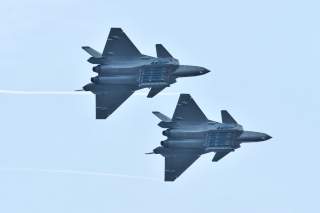China Wants a 6 Carrier Navy with J-20 Stealth Fighters
A powerful fleet.
Key point: China is making rapid progress in achieving a major carrier-based navy.
The Chinese military has decided to develop the air force’s J-20 stealth fighter into a sea-based variant to fly from the navy’s growing fleet of aircraft carriers.
The Central Military Commission, the People’s Liberation Army’s top decision-making body, favors the J-20 over the smaller FC-31 stealth fighter design, according to the Hong Kong South China Morning Post.
The Chengdu Aerospace Corporation, which builds the J-20 for the air force, “will announce some new products, which will include a new version of their J-20,” an unnamed source told the newspaper. “You can guess what type it will be.”
If the selection of the J-20 is confirmed it will mark the end of a lengthy debate between its supporters and advocates of the FC-31 as to which would make a better carrier-based fighter.
Those who favored the J-20 said it was more advanced and reliable than the FC-31, but its supporters said it was more light and nimble.
“Both the J-20 and FC-31 have their advantages. The size of the J-20 is similar to the J-15 since both are powerful heavy fighters,” Song Zhongping, a military commentator for Hong Kong-based Phoenix Television, said.
The carrier-based J-20 partially would replace the J-15, China’s first carrier fighter.
The J-15 is a clone of Russia's Su-33 naval fighter. Outwardly, the fighter has a lot in common with U.S., French and British carrier planes. "The J-15 has folding wings, strengthened landing gear, a tailhook under a shortened tail stinger, two-piece slotted flaps, canards and a retractable inflight-refueling probe on the left side of the nose," the U.S. Defense Intelligence Agency explained in a January 2019 report.
The non-stealthy J-15 weighs 17 tons while empty and can launch via the ramp on the bow of China’s first two carriers, which lack catapults. But the ramp-launch method limits the J-15 to around 30 tons maximum weight, translating into a modest weapons load. The J-15 reportedly also is unreliable and accident-prone.
The J-20, which weighs 21 tons without fuel and weapons and up to 40 tons with them, likely will require a catapult for launch.
The U.S. Navy's carriers use steam catapults to launch aircraft weighing as much as 50 tons. The Chinese navy could commission its first catapult-equipped aircraft carrier in 2022, according to the May 2019 edition of the U.S. Defense Department’s annual report on Chinese military developments.
“China began construction of its second domestically built aircraft carrier in 2018, which will likely be larger and fitted with a catapult launch system,” the DIA noted. “This design will enable it to support additional fighter aircraft, fixed-wing early-warning aircraft, and more rapid flight operations. China’s second domestically built carrier is projected to be operational by 2022.”
The older flattops Liaoning and Shandong should remain useful even after the second domestic carrier -- China’s third flattop -- enters service. "Though Liaoning has substantially less capability than a U.S. Navy carrier, it provides extended air-defense coverage for at-sea task groups and is being used to develop further China’s carrier pilots, deck crews and tactics," the Pentagon noted in the 2018 edition of its annual report on the Chinese military.
Still, China's first two flattops probably won’t venture too far from home, the DIA predicted. "The primary purpose of this first domestic aircraft carrier will be to serve a regional defense mission," the intelligence agency claimed. "Beijing probably also will use the carrier to project power throughout the South China Sea and possibly into the Indian Ocean."
The Chinese navy could possess as many as six aircraft carriers by the mid-2030s, experts told state media. As many as four could have catapults.
Song Zhongping, a military expert and T.V. commentator, told Global Times that China needs at least five aircraft carriers to execute its military strategy. Wang Yunfei, a retired Chinese navy officer, said Beijing needs six flattops.
Six carriers might allow Beijing to equip each of its regional fleets with two flattops. One vessel could deploy while the other underwent maintenance.
If Chengdu does develop a carrier-based J-20, the Chinese navy eventually could operate a mixed carrier fleet including two small flattops with J-15s and as many as four bigger vessels with J-20s.
David Axe serves as Defense Editor of the National Interest. He is the author of the graphic novels War Fix,War Is Boring and Machete Squad. This first appeared in August 2019.
Image: Reuters.

